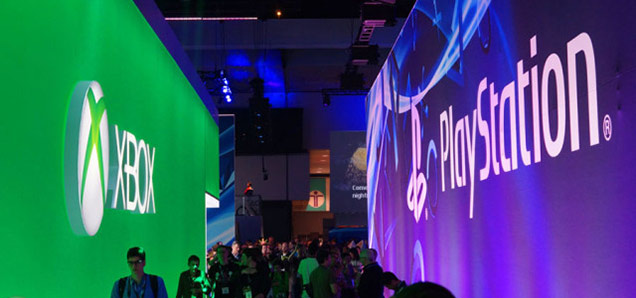First shots fired in the new console war
 CREDIT: HUBERT NGUYEN AT UBERGIZMO.COM
CREDIT: HUBERT NGUYEN AT UBERGIZMO.COMGamers are eagerly anticipating the release of the new Microsoft console, Xbox One (left) and Sony�s new console, PlayStation 4.
The Electronics Entertainment Exhibition (E3) serves as an annual platform for those in the video game industry to showcase the innovations they will bring to gamers in the coming years. The ‘big three' game console developers - Sony, Microsoft and Nintendo — have used the opportunity presented by E3 to try and prove time and time again that their brand is the one that gamers should be spending their hard earned money on, while multiplatform publishers such as Ubisoft and EA showcase the upcoming titles that they will offer to all gamers.
While the emphasis at E3 is traditionally on upcoming game titles, this year, the focus of developers, publishers, journalists and gamers alike was on one thing: the birth of a new generation of consoles. Both Microsoft and Sony used the conference mainly to showcase their upcoming game consoles, the Xbox One and PlayStation 4 respectively, which are both set to launch in November for the holiday season. These two entertainment giants unveiled new technologies, services and, most importantly, games in an effort to convince gamers that their system should be the one they purchase.
When the previous console generation began with the launch of the Xbox 360, Microsoft was riding a high note with the success that was found in their first foray into video games with the original Xbox, which sold over 24 million units, largely due to the popularity of their Halo series. With this in mind, they ambitiously launched their second console a year before their competitors in November of 2005. The Xbox 360, while finding great initial success in North American markets, soon recieved reports of technical errors, mainly the infamous “red ring of death,” a visual indication of an irreparable hardware error, that would appear for no apparent reason. Despite this, and its lack of popularity in Asia, a stellar lineup of games such as the Gears of War franchise and the continued success of the Halo series saw the Xbox 360 selling 77.2 million units before April of 2013.
A year later, Sony revealed the PlayStation 3, launching with two models priced at $500 and $600, a high price point that was criticized by consumers and video game media alike. This, as well as a failure to meet its launch quota and an underwhelming library of games at launch (the exception being the excellent Resistance: Fall of Man), Sony fell behind early in the console race. However, a price drop and the release of the critically acclaimed Uncharted series, among other excellent releases and features such as free to play online, allowed the PlayStation 3 to catch up to its competitors' lead and tie the amount of systems sold.
Moving forward, Microsoft and Sony are taking two very different directions with their new consoles. For the PlayStation 4, Sony is sticking with a model that is virtually identical to what they have for the PlayStation 3, an approach that is in direct contrast to the more radical direction that Microsoft is taking with their Xbox One.
The PlayStation 4 is offering a small, sleek-looking console with more processing power than its competitor priced at $399 - $100 less than the Xbox One's launch price. While this alone is more attractive to consumers, it is the operating features of the two consoles that have divided opinions.
Both systems offer direct downloads of games though their online stores, and while this may seem like a feature that people would welcome, Microsoft has introduced several policies that have irked the gaming public. The largest outcry has come from the system's requirement to connect to the Internet once every 24 hours; failing to do so will render play inoperable until a connection can be re-established. This requirement alienates millions of potential customers around the world, many of whom are loyal customers to Microsoft, who do not have access to a reliable Internet connection, such as members of the military, many of whom game in their spare time while deployed.
By sticking to what has worked for them in the past, Sony has taken the early lead in customer approval, shown most tellingly on a recent poll conducted by Amazon.com on Facebook asking the public which system they preferred. The poll was closed early, with the PlayStation 4 receiving over 40,000 votes, compared to Xbox One's 2,100, an overwhelming 95 per cent of the vote.
It remains to be seen how the two consoles fare come their launches in November, it clear that right now the public opinion is leaning toward the more consumer-friendly approach taken by Sony, but Microsoft will rely on the game shown for their system, as well as old standard such as Halo to drive the public opinion back their way. Like in so many of the games played on each system, the console war is a long battle between these two console giants, with many years before we will know who has truly won.
Update - June 20, 2013
On June 19, Microsoft announced it was removing some of the policies it initially announced for the Xbox One at the E3 conference: an Internet connection will not be required to play offline games; the system will not check the Internet connection every 24 hours; and players will be able trade in, lend, and resell their games.
To read Microsoft's full statement, go to news.xbox.com/2013/06/update.













